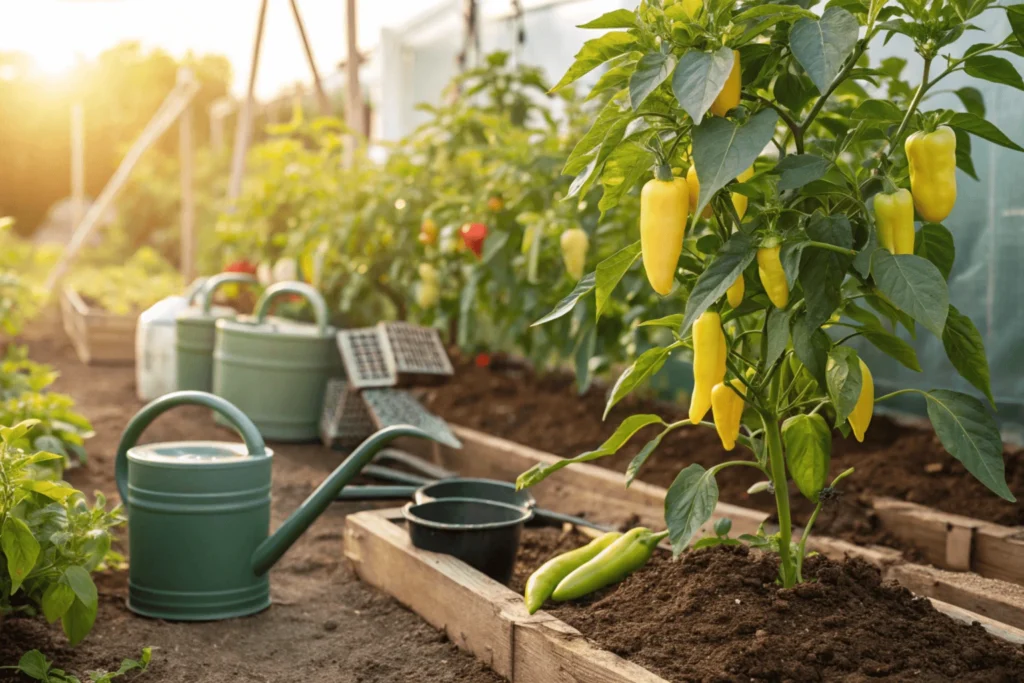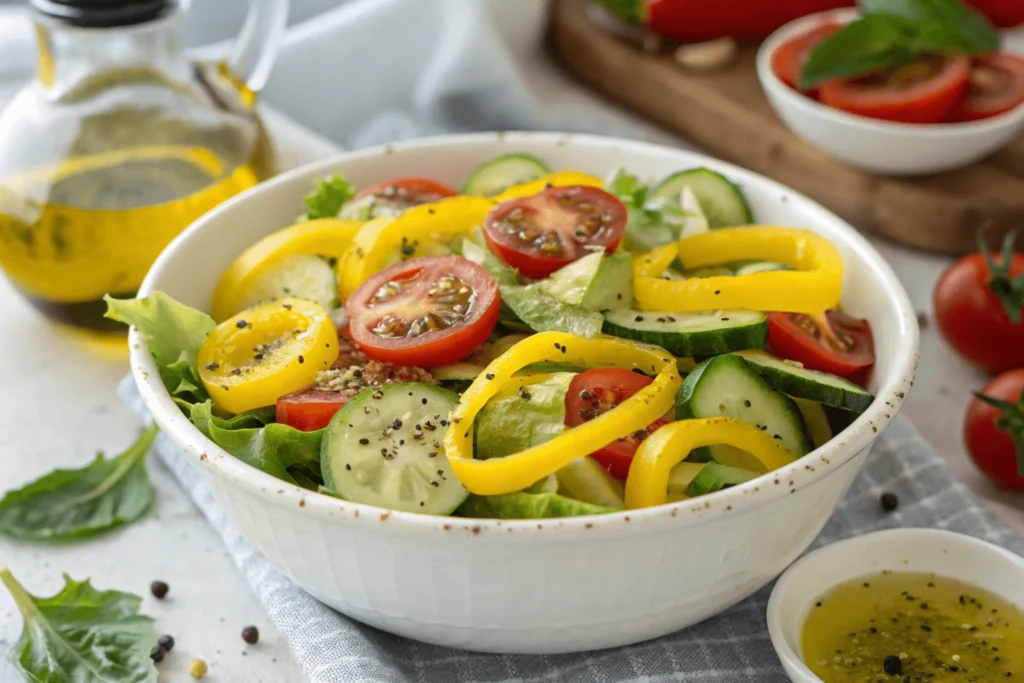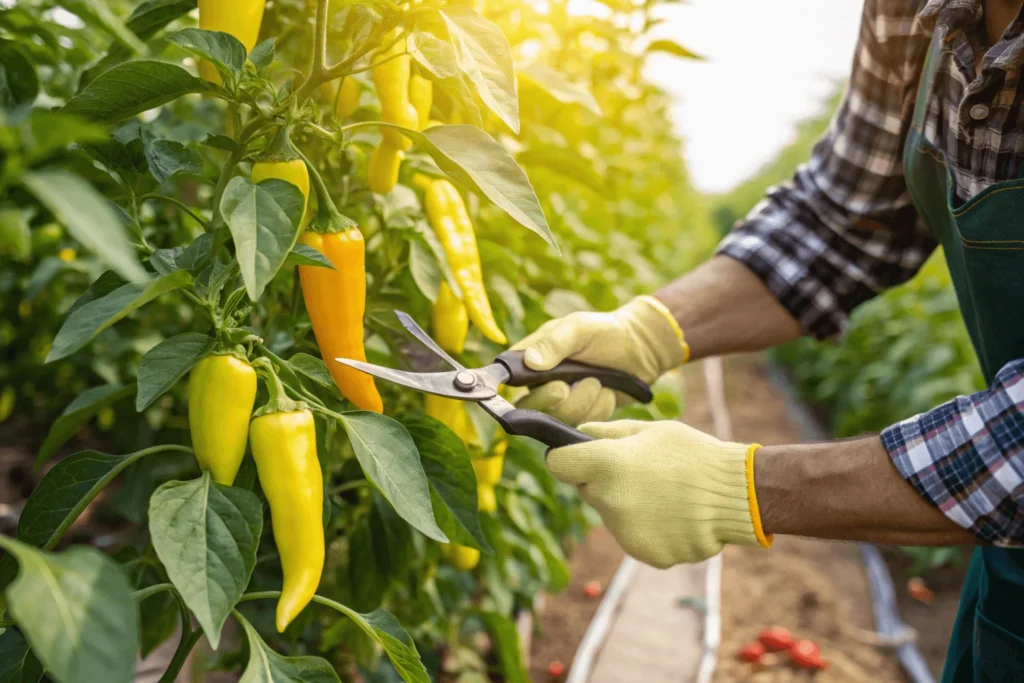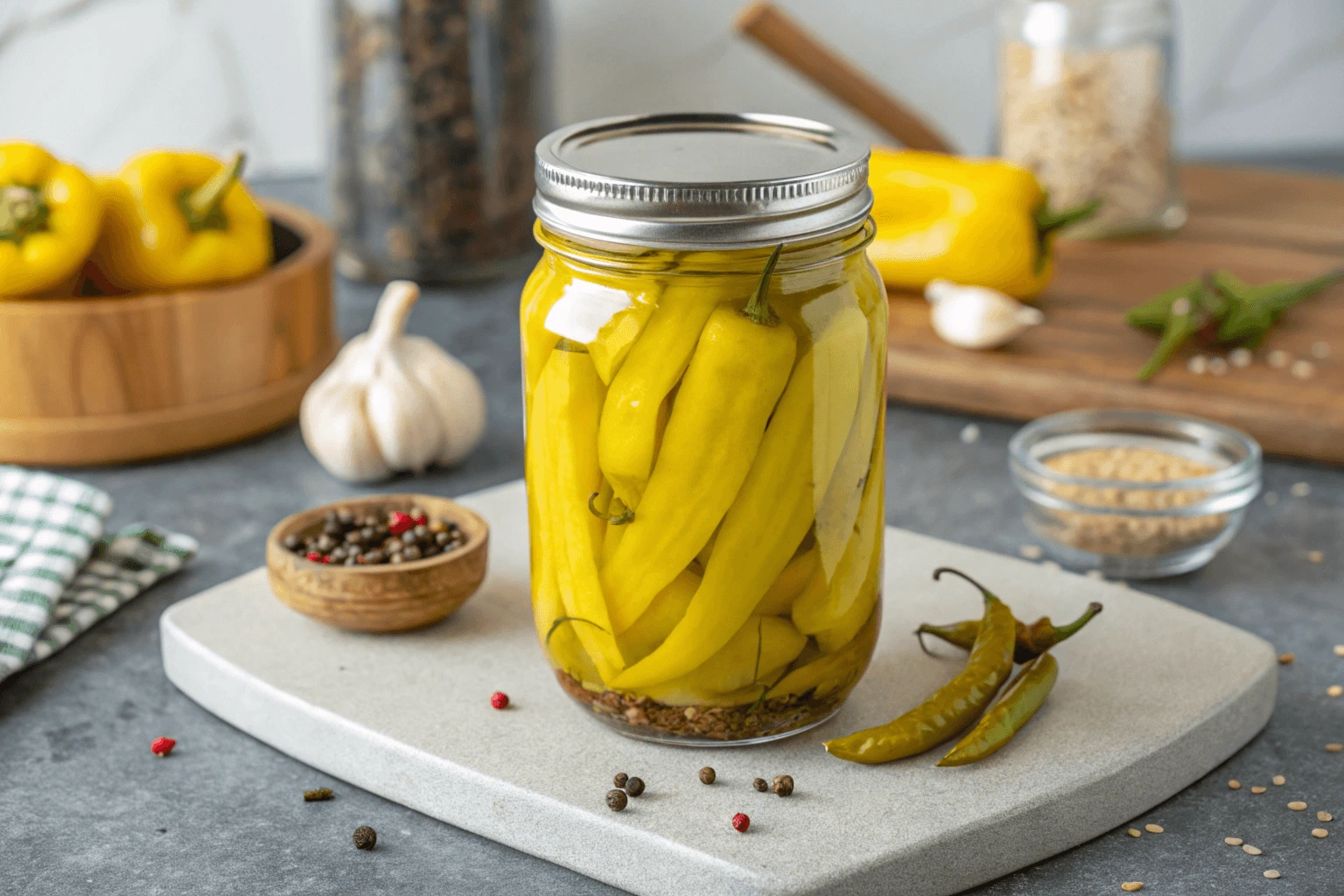Banana peppers might just be the most underrated vegetable in your grocery store’s produce section. These vibrant yellow beauties pack a surprising nutritional punch while delivering just enough mild heat to wake up your taste buds without setting your mouth on fire. If you’ve been walking past banana peppers at the market, you’re missing out on one of the most versatile ingredients that can transform everything from sandwiches to pizzas.
Banana peppers, named for their distinctive curved shape and bright yellow color, are the perfect gateway pepper for those who want to add flavor without overwhelming heat. Ranking only 0-500 on the Scoville scale, these mild peppers offer a tangy, slightly sweet taste that enhances dishes rather than dominating them. Whether you’re a heat-sensitive foodie or a pepper enthusiast looking for a milder option, banana peppers deserve a permanent spot in your kitchen.
In this comprehensive guide, we’ll explore everything you need to know about banana peppers—from their impressive health benefits and nutritional profile to creative ways to use them in your cooking. You’ll discover the difference between banana peppers and their often-confused cousin, pepperoncini, learn how to grow your own pepper plants, and find delicious recipes that showcase these versatile vegetables. By the end of this article, you’ll understand why banana peppers have become a favorite among home cooks and professional chefs alike.
Table of Contents

What Are Banana Peppers?
Banana peppers are a type of chili pepper that are widely recognized for their mild heat and tangy flavor. They are commonly used in various cuisines around the world, particularly in salads, sandwiches, and pickled preparations. While they are often referred to as “banana” peppers due to their curved, elongated shape, they are part of the Capsicum annuum species, which is a broad family of peppers that also includes bell peppers, jalapeños, and many others.
Definition: What Banana Peppers Are and Their Scientific Name (Capsicum annuum)
Banana peppers are part of the Capsicum annuum species, which includes a wide variety of chili peppers. These peppers are typically mild to moderately spicy, with a slight tang and a sweet undertone in their taste. They are named “banana peppers” due to their shape, which resembles that of a banana—long, slender, and curved. Their mild heat makes them an excellent choice for those who want to enjoy the flavor of chili peppers without the intense burn typically associated with spicier varieties like jalapeños or habaneros.
Varieties: Different Types of Banana Peppers (Sweet vs. Hot Banana Peppers)
Banana peppers come in both sweet and hot varieties, offering a range of flavor profiles depending on the specific type.
- Sweet Banana Peppers: These are the most commonly used and are mild in flavor. They have a slight sweetness to them, with very little heat. They are often found in pickled form and are popular as a topping for sandwiches and salads.
- Hot Banana Peppers: While still on the milder side compared to other chili peppers, hot banana peppers have a noticeable heat that can provide a more intense flavor. They are usually used fresh or pickled and are often featured in salsas and hot sauces.
The level of heat in banana peppers varies depending on growing conditions and the specific variety, but generally, they range from 0 to 500 Scoville Heat Units (SHU), placing them at the lower end of the heat scale.
Appearance: Description of Their Color, Shape, and Size
Banana peppers are long and slender, typically ranging from 2 to 6 inches in length. Their shape is curved, much like a banana, which is how they get their name. The color of banana peppers starts as light yellow when they are young and ripens into a deep yellow or sometimes even red or orange as they mature. The skin is smooth, and the peppers have a glossy finish.
- Size: Banana peppers are generally medium-sized, though hot varieties can sometimes grow a little larger. They are often harvested while still green or yellow, though leaving them to ripen fully will yield a slightly sweeter flavor.
- Shape and Texture: The peppers have a smooth, firm texture and a slightly waxy skin, which makes them ideal for pickling and canning.
Origin: Brief History of Banana Peppers and Their Origins
Banana peppers are believed to have originated in South and Central America, where they were cultivated by indigenous peoples long before European colonization. Over time, they spread throughout North America, Europe, and other parts of the world. Their mild flavor and adaptability made them popular for a variety of uses, from fresh eating to preservation methods like pickling.
In the United States, banana peppers became particularly popular in the 20th century as they became a staple in Mediterranean and Italian-inspired cuisine. Today, they are commonly found in supermarkets across the globe, and home gardeners often grow them in their backyard gardens. Their mild heat and versatility make them a favorite for cooks looking to add a bit of spice without overwhelming other flavors in a dish.
Health Benefits of Banana Peppers
are not only a flavorful addition to your meals, but they also offer a variety of health benefits. Packed with essential nutrients, these peppers can contribute to your overall well-being while adding a delicious twist to your dishes. Let’s dive deeper into the specific health benefits of banana peppers.
Rich in Nutrients: Highlighting Vitamins (Like Vitamin C) and Minerals
Banana peppers are a nutritional powerhouse, offering a wide range of essential vitamins and minerals. A key nutrient in banana peppers is Vitamin C, which is crucial for immune function, skin health, and the absorption of iron. Just one medium-sized banana pepper can provide a significant portion of your daily Vitamin C needs, helping to fight free radicals and promote healthy collagen production.
In addition to Vitamin C, banana peppers also contain important minerals such as potassium, which supports heart health by helping to regulate blood pressure, and magnesium, which is essential for muscle function and bone health. These nutrients make banana peppers a great addition to any diet, supporting everything from hydration to cellular health.
Low in Calories: Why Banana Peppers Are a Healthy Snack Choice
One of the most appealing aspects of banana peppers is their low calorie content. A single medium-sized contains only around 20 calories, making it an excellent choice for anyone looking to snack without overindulging. Whether you enjoy them raw, pickled, or as part of a dish, banana peppers are a guilt-free snack that can satisfy your craving for something crunchy and flavorful without adding excess calories to your diet.
Their low-calorie nature makes them especially great for those on weight management plans or anyone seeking healthier alternatives to high-calorie snacks like chips and processed foods.
Boosting Immunity: How Banana Peppers Contribute to a Stronger Immune System
Thanks to their Vitamin C content, banana peppers play a significant role in boosting the immune system. Vitamin C is a well-known antioxidant that helps strengthen the immune system by protecting cells from oxidative damage caused by free radicals. It also enhances the production of white blood cells, which are essential for fighting infections.
Moreover, banana peppers contain capsaicin (in hotter varieties), which has anti-inflammatory properties that support immune health. By adding banana peppers to your diet, you can enhance your body’s ability to ward off illness and stay healthy year-round.
Supporting Digestive Health: Benefits of Fiber and Antioxidants
Banana peppers are a good source of fiber, which is vital for maintaining a healthy digestive system. Fiber aids in regulating bowel movements, preventing constipation, and supporting overall digestive health. A high-fiber diet can also aid in weight management and lower the risk of certain digestive issues, such as diverticulitis and irritable bowel syndrome (IBS).
Additionally, banana peppers contain antioxidants, such as carotenoids and flavonoids, which help reduce inflammation and protect the digestive tract from oxidative stress. These antioxidants support the body’s natural detoxification processes and contribute to a healthy microbiome, which is essential for optimal digestion and nutrient absorption.
How to Cook and Use Banana Peppers
are incredibly versatile and can be used in a variety of ways to enhance the flavor of your dishes. Whether you’re pickling them, adding them to savory meals, or seasoning your dishes with their tangy taste, these peppers can make any recipe more exciting. Here are some of the most popular ways to use banana peppers:

Pickled Banana Peppers: Step-by-Step Guide on How to Pickle Them
Pickling banana peppers is a simple and rewarding way to preserve them for later use, while also bringing out their natural tanginess. Here’s how you can pickle them at home:
- Ingredients:
- Fresh banana peppers
- White vinegar or apple cider vinegar
- Water
- Salt
- Sugar (optional, for a sweeter taste)
- Garlic, peppercorns, mustard seeds, or any herbs you like for added flavor
- Instructions:
- Prepare the Peppers: Rinse the banana peppers well and either slice them into rings or leave them whole, based on your preference. If you leave them whole, be sure to pierce them with a fork to allow the brine to seep in.
- Prepare the Brine: In a saucepan, combine equal parts water and vinegar, adding salt and sugar to taste. Bring the mixture to a boil until the salt and sugar are fully dissolved.
- Sterilize Jars: Sterilize glass jars by boiling them in water for a few minutes or running them through the dishwasher. This helps keep your pickled peppers fresh.
- Pack the Peppers: Carefully pack the banana peppers into the sterilized jars, leaving some space at the top.
- Add the Brine: Pour the hot brine over the peppers in the jars, covering them completely.
- Seal and Cool: Seal the jars tightly and let them cool to room temperature. Once cooled, store them in the fridge for at least 24 hours before enjoying. The more time they have to sit, the richer their flavor becomes!
Pickled banana peppers make a tangy snack on their own or can be added to sandwiches, tacos, burgers, and salads for an extra burst of flavor.
Cooking with Banana Peppers: Adding Banana Peppers to Various Dishes Like Salads, Sandwiches, and Stews
Banana peppers can be used fresh or cooked to enhance the flavor of many dishes. Their mild heat and slightly sweet taste make them a great addition to both savory and spicy recipes:
- Salads: Slice banana peppers and toss them into your favorite salad for an extra crunch and zing. They pair well with leafy greens, tomatoes, onions, and cucumbers.
- Sandwiches and Wraps: Add fresh or pickled banana peppers to sandwiches and wraps for a tangy kick. They’re especially great with deli meats like turkey, roast beef, or chicken, as well as vegetarian options like hummus and avocado.
- Stews and Soups: For a subtle heat, throw sliced banana peppers into stews, soups, or chili. They work particularly well in Mediterranean-inspired dishes or vegetable-based soups.
- Pizza Topping: Top your pizza with sliced banana peppers for a mild and colorful addition. Their acidity balances well with the richness of cheese and tomato sauce.
Banana peppers can be paired with almost anything, offering a burst of flavor without overwhelming the dish.
In Mediterranean Cuisine: How They Are Used in Mediterranean Dishes
Banana peppers are a staple in Mediterranean cuisine, where they add both flavor and texture to a variety of dishes. Here’s how they are commonly used:
- Stuffed Banana Peppers: In Mediterranean cooking, banana peppers are often stuffed with a mixture of rice, herbs, spices, and sometimes cheese or meat. This dish is both filling and flavorful, offering a wonderful balance of flavors.
- Grilled Banana Peppers: Grilled banana peppers are a popular side dish or appetizer in Mediterranean regions. They are often charred to bring out their sweetness, then drizzled with olive oil, lemon juice, and herbs like oregano or basil.
- Salads and Mezze Platters: Banana peppers are frequently included in Greek-style salads or served as part of mezze platters. Their crunchy texture complements other ingredients like olives, feta cheese, tomatoes, and cucumbers.
- In Roasted Dishes: Banana peppers are often added to roasted vegetable medleys in Mediterranean meals. Roasting banana peppers enhances their natural sweetness and allows them to complement other vegetables beautifully.
Banana peppers add a unique and refreshing element to Mediterranean cuisine, making them a must-have in a variety of dishes.
Spicing Up Recipes: Banana Pepper Seasoning for Added Flavor
If you’re looking for an easy way to spice up your dishes, banana pepper seasoning is the way to go. It’s simple to make and adds a burst of flavor to almost any meal. Here’s how you can make your own banana pepper seasoning at home:
- Ingredients:
- Dried banana peppers (either from pickled peppers or air-dried banana peppers)
- Garlic powder
- Onion powder
- Paprika
- Red pepper flakes (optional for extra heat)
- Salt and pepper to taste
- Instructions:
- Prepare the Peppers: If you have dried banana peppers, grind them into a fine powder using a spice grinder or mortar and pestle. If you don’t have dried banana peppers, you can use pickled banana peppers and dehydrate them.
- Mix the Seasonings: In a bowl, combine the ground banana pepper with garlic powder, onion powder, paprika, and red pepper flakes. Adjust the seasoning to your taste by adding more salt or spice.
- Store: Store the seasoning in an airtight container for up to six months.
This banana pepper seasoning can be sprinkled over salads, roasted vegetables, meats, or used as a marinade base for grilling. It’s perfect for adding just the right amount of heat and tang to any dish.
Banana Peppers vs. Pepperoncini: What's the Difference?
Banana peppers may look similar to other peppers, but they stand out for their unique flavor and heat level. In this section, we will compare banana peppers to other popular types of peppers, such as jalapeños and bell peppers, in terms of heat, taste, and health benefits.
Heat Comparison: Comparing Banana Peppers with Other Peppers (Scoville Heat Scale)
One of the most defining characteristics of any pepper is its heat level, measured by the Scoville Heat Scale. Banana peppers are mild on this scale, ranging from 0 to 500 Scoville Heat Units (SHU), making them significantly milder than some of their pepper counterparts.
- Banana Peppers (0-500 SHU): These peppers are known for their mild heat, which makes them suitable for people who prefer a bit of spice without overwhelming their taste buds.
- Jalapeños (3,500-8,000 SHU): In comparison, jalapeños pack a much hotter punch. With a heat range significantly higher than banana peppers, they can add a spicier kick to dishes.
- Bell Peppers (0 SHU): On the other hand, bell peppers are completely sweet with no heat at all. They are often used for their crunch and mild flavor, which differs from the subtle spice found in banana peppers.
This heat comparison helps you choose the right pepper depending on the level of spice you’re comfortable with. If you want a more intense flavor, jalapeños may be the way to go, while banana peppers are ideal for those looking for a more mild and balanced heat.
Sweet vs. Hot: The Difference in Taste and How to Choose Based on Your Preference
When it comes to taste, banana peppers are known for their slight tang and mild heat. They are typically sweeter than many hot peppers, offering a delicate balance between flavor and spice. Depending on the variety, banana peppers can either be sweet or mildly hot, giving you options to suit your preference:
- Sweet Banana Peppers: These peppers are favored for their crisp texture and sweet flavor. They are perfect for those who enjoy a hint of spice without the burn. Sweet banana peppers are commonly used in salads, sandwiches, or pickled to add a flavorful yet non-spicy crunch.
- Hot Banana Peppers: Although still milder than jalapeños, the hot variety of banana peppers has a more pronounced heat that can complement dishes that need a little extra kick. These peppers are great for adding depth to salsas, sauces, or even stuffed with cheese and other ingredients for a spicy snack.
If you’re unsure which type to choose, it really comes down to how much heat you want in your food. For a less intense heat, go for the sweet variety, while the hot banana pepper will satisfy those looking for a bit more spice.

Banana Pepper Nutrition and Health Benefits
When it comes to nutrition, banana peppers offer a wealth of health benefits that make them a great addition to any diet. While bell peppers and other varieties of peppers also provide numerous health advantages, banana peppers have some unique attributes:
- Banana Peppers: These peppers are low in calories, with just 10-15 calories per pepper. They are rich in Vitamin C, an essential nutrient that supports immune health and helps protect against cell damage. Additionally, banana peppers provide fiber, antioxidants, and small amounts of vitamins like A and B6. Their antioxidant content can help reduce inflammation and promote overall health.
- Bell Peppers: Like banana peppers, bell peppers are an excellent source of Vitamin C, but they also contain more Vitamin A, which is beneficial for eye health and immune function. Bell peppers are also a great source of carotenoids, which are known for their antioxidant properties.
- Jalapeños: While jalapeños are hotter than banana peppers, they also offer some unique health benefits. They contain capsaicin, the compound responsible for their heat, which has been shown to have pain-relieving properties and may help boost metabolism. Jalapeños are also high in Vitamin C, A, and several B vitamins, which contribute to overall health and well-being.
In terms of health benefits, banana peppers are similar to bell peppers but with a unique twist: their mild heat offers a little extra zing while still providing the same essential nutrients, making them an excellent choice for anyone looking to add both flavor and health benefits to their diet.
Growing and Harvesting
Banana peppers are a relatively easy and rewarding vegetable to grow, whether you’re a seasoned gardener or a beginner. With the right care and conditions, you can enjoy a bountiful harvest of these flavorful peppers right from your garden. Here’s a detailed look at how to successfully grow and harvest banana peppers.
For more detailed gardening tips and expert advice, check out this guide on growing peppers from Gardening Know How.
Planting Banana Peppers: Tips for Growing Banana Peppers at Home
To get started, banana peppers thrive in warm conditions, so they are best planted after the last frost when the soil has warmed up. Here are some key tips to help you grow them successfully:
- Start from Seeds or Transplants: You can either start banana pepper seeds indoors about 8-10 weeks before the last frost date or purchase young plants (transplants) from a local nursery.
- Planting Depth: When planting seeds, bury them about 1/4 inch deep in a seed tray or pots. If using transplants, place them 18-24 inches apart in well-drained soil.
- Spacing: Banana pepper plants should be spaced to allow for good airflow, which helps prevent disease. Make sure there’s at least 18 inches between each plant.
- Transplanting: If starting indoors, transplant seedlings to your garden once they are 3-4 inches tall and after the soil has reached a consistent warm temperature.
Optimal Growing Conditions: Sunlight, Soil, and Watering Tips
BP require specific growing conditions to flourish. Here’s how to provide the ideal environment:
- Sunlight: Banana peppers need full sunlight to grow well. Aim for 6-8 hours of direct sunlight each day to encourage strong, healthy plants.
- Soil: Plant them in well-draining, loamy soil that is slightly acidic to neutral (pH 6.0-6.8). Rich, fertile soil will help promote better growth and fruit production.
- Watering: Maintain consistent moisture in the soil without making it waterlogged.. Water deeply at the base of the plants, especially during hot weather, ensuring that the soil remains consistently moist but not soaked. Refrain from wetting the leaves to minimize the chance of fungal diseases.
- Fertilizing: Apply a balanced fertilizer to promote healthy growth, but avoid over-fertilizing, as too much nitrogen can lead to excessive leaf growth at the expense of peppers.
Harvesting Time: When and How to Harvest Banana Peppers for the Best Flavor
is typically take around 70-80 days from planting to reach maturity. Here’s when and how to harvest them:
- Timing: You can harvest banana peppers when they are still green or wait until they ripen to a yellow or red color. Green peppers are milder, while the yellow or red ones have a slightly sweeter taste.
- Pick at the Right Time: The best time to harvest is when the peppers are firm, glossy, and have reached their full size (usually 4-6 inches long).
- How to Harvest: Use scissors or pruning shears to cut the peppers from the plant. Avoid pulling them by hand, as this can damage the plant or break the stem. Leave a small portion of the stem attached to the pepper for longer shelf life.
- Encouraging Continued Growth: After harvesting, trim back any overgrown stems or leaves to allow the plant to produce more peppers throughout the growing season.
Storage Tips: How to Preserve Banana Peppers, Including Drying and Freezing
Once you’ve harvested your banana peppers, you’ll want to know how to preserve them for later use. Here are several ways to keep your peppers fresh:
- Refrigeration: Fresh banana peppers can be stored in the refrigerator for up to two weeks. Place them in a paper towel-lined bag to absorb moisture and keep them crisp.
- Freezing: If you want to store banana peppers long-term, freezing is a great option. Rinse and pat dry the peppers, then cut off the stems and remove the seeds. Slice them into rings or leave them whole before placing them on a baking sheet to freeze individually. Once frozen, transfer them to a freezer-safe bag or container for up to 6 months.
- Drying: Drying banana peppers is another way to preserve them. You can use a food dehydrator or an oven set to a low temperature (around 125°F) to dry them. Once completely dried, store the peppers in an airtight container or jar in a cool, dark place for up to a year.
- Pickling: If you enjoy the tangy flavor of pickled peppers, this is a fantastic way to preserve banana peppers. Simply slice them and pack them in jars with vinegar, water, salt, and seasonings. The pickled peppers will last for several months when stored in the refrigerator.
By following these tips, you can grow, harvest, and preserve banana peppers, ensuring that you have a steady supply of this flavorful vegetable all year long!
FAQs
Are banana peppers spicy?
No, banana peppers are not considered spicy. They are very mild and rank between 0 and 500 on the Scoville Heat Units (SHU) scale. For comparison, a bell pepper has 0 SHU, and a jalapeño pepper ranges from 2,500 to 8,000 SHU. Their flavor is mostly tangy and slightly sweet, making them suitable for people who do not enjoy spicy food.
Can you eat banana peppers raw?
Absolutely! Raw banana peppers are delicious. They have a crisp, crunchy texture and a fresh, tangy flavor. They are a fantastic addition to green salads, sandwiches, and wraps for a bit of extra zest and crunch. You can also slice them into rings and serve them on a veggie platter with dip.
What is a good substitute for banana peppers?
The best substitute depends on whether you need a replacement for fresh or pickled banana peppers.
For Pickled Banana Peppers: The best substitute is pepperoncini. They have a similar tangy flavor, although pepperoncini can be slightly spicier and have a thinner skin.
For Fresh Banana Peppers: A yellow bell pepper is a great substitute for replicating the color and crunchy texture without any heat. For a similar shape and mild flavor, an Anaheim pepper also works well, though it can have a tiny bit more heat.
How long do pickled banana peppers last?
An unopened, commercially-canned jar of pickled banana peppers can last for years if stored in a cool, dark place. Once opened, they should be stored in the refrigerator and will typically stay fresh for 2-3 months. Always check for signs of spoilage like a foul odor, mold, or a cloudy brine before consuming.
Are banana peppers good for weight loss?
Yes, banana peppers can be a great food to include in a weight-loss diet. They are:
Very low in calories and fat.
A good source of fiber, which helps you feel full and aids digestion.
High in water content, which contributes to hydration.
Adding them to meals provides a burst of flavor without adding significant calories, making your diet food more enjoyable and sustainable.
Conclusion
Banana peppers are not only a flavorful addition to many dishes, but they also offer a range of health benefits, making them a fantastic choice for any garden or kitchen. Whether you’re growing them at home or enjoying them in your favorite recipes, these versatile peppers can elevate your meals with their mild tang and vibrant color. By understanding the best growing conditions, knowing when to harvest, and learning how to preserve them, you can enjoy banana peppers throughout the year. From pickling to freezing, there are many ways to store them for future use. So, why not add banana peppers to your gardening or cooking plans and experience their unique flavor and health benefits firsthand? Happy growing and cooking!



1 thought on “Everything You Need to Know About Banana Peppers: Benefits and Uses”
Comments are closed.